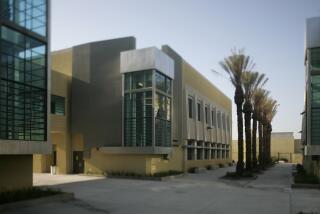Shane Thomas: How rising soccer star’s life tragically ended
- Share via
John Thomas would happily wake up at 5:30 a.m. to drive his son, Shane, from their home in View Park-Windsor Hills to Palisades High for three years. A 16-mile drive could take more than one hour in morning traffic. The drive home would take even longer. He also attended every Palisades soccer game, where Shane was the team’s leading scorer, with 19 goals last season.
“My son was my driving force,” said Thomas, who owns a decal business, which allowed him to be flexible with his schedule so he could provide first-hand support to his son’s soccer pursuits. “I told him as long as he did his best and worked hard, I didn’t mind taking him to the end of the earth.”
Thomas and his wife, Valerie, were determined to help 17-year-old Shane make the most of his passion for soccer. Shane tried out in June for the prestigious FC Golden State club team at the recommendation of Tony Leone, a family friend who helped train Shane. Again, it involved more driving, since the team practiced at Ayala Park in Chino, a 140-acre sports complex nearly 50 miles from their home. Shane made the under-19 team.
Last Saturday, on one of the hottest days of the year, the club team held a 10 a.m. training session to prepare for tournament play this fall. John and Valerie found a shaded area to watch and had their usual cooler filled with drinks. Shane made sure he stayed hydrated with water and electrolytes. By 11:25 a.m., when practice was finished, the temperature was headed toward a noon high of 111 degrees, according to weather reports.
“We watched him the whole practice. He seemed fine, and at the end of practice, he was joking with coaches,” John said.
Shane was given the assignment of carrying a ball bag as teammates gathered cones, other balls and equipment from around the field.
“We have strict protocols,” said Jimmy Nordberg, executive director of FC Golden State. “All boys collect the balls and put them in the middle of the field to count them.”
Several minutes passed, and his parents were asked if they knew where Shane had gone. He was missing. Teammates were sent to find him. Restrooms were checked. His name was called out around field No. 11. At 11:58 a.m., Chino police responded to a report of a missing person.
Police contacted John and a short time later dispatch received a call that two teammates had found Shane in an area west of the complex’s batting cages about 400 yards away from the soccer field. He was unresponsive and not breathing. Police personnel began CPR. Chino fire department personnel arrived at 12:14 p.m. and took over.
Shane was taken to Chino Valley Medical Center, where he was pronounced dead at 1:13 p.m.
The cause won’t be known until autopsy results are available, which could take weeks.
“It was just by God’s will,” John said in a phone conversation this week. “It was a freak thing. It was his time.”
::
Soccer became important to the Thomas family when Shane’s sister, Cheyenne, started playing the sport as a child and later at Culver City High. “He was always the mascot on the sideline,” Cheyenne, 24, said of her brother.
John tried to get Shane interested in basketball. “It was not pretty,” he said.
Shane attended Palisades instead of Culver City because of the Dolphins’ soccer program, one of the best in the City Section. His dream was to be a professional soccer player.
“He was an incredible person, an incredible teammate, an incredible leader,” Palisades coach Marvin Lemus said. “He was on varsity since ninth grade. He was vocal and you could feel his presence.”
John drove Shane to L.A. Cathedral last year for private workouts with assistant coach German Munoz.
“His attitude was one of a kind,” Munoz said. “He was always early. He was always ready to learn, always asked questions.”
Munoz noticed a special bond between father and son.
“It was a team,” he said. “It was Shane and John. I was very glad to see a parent that involved in his son’s future. The best part was John talking about sessions when he couldn’t make practice. John used to play tennis. He had good footwork. He’d teach Shane to have good footwork. Shane would smile, ‘Yep, that’s my dad.’”
His coachability, his eagerness to get better were some of the things our coaches fell in love with. The guys on the team adored him.
— Jimmy Nordberg, FC Golden State executive director
John said, “I wanted my son to be God-fearing, healthy and happy. I would ask him every four or five months, if you could do anything you wanted to do on the planet, what would you want to do? ‘Be a professional soccer player.’ I’ve done that all his life. And I didn’t even like soccer.”
This summer, leading up to Shane’s senior year, was going to be critical to his development.
“The last time I saw Shane he was in the best shape of his life,” Lemus said. “He looked very sharp and fit. We did some ball work and fitness. While everyone else was tired, I asked, ‘Shane, are you tired?’ He said, ‘No, coach, I’m in shape and I’ve been working out. I’m ready for the upcoming season.’”
Shane had already made an impression on his new club team. Based in Pomona and Pasadena, FC Golden State was part of the old U.S. Soccer Developmental Academy but wasn’t one of the 94 teams selected for the new MLS elite development program. It has boys and girls teams for 13-year-olds and up.
“His attitude was terrific,” Nordberg said. “His coachability, his eagerness to get better were some of the things our coaches fell in love with. The guys on the team adored him.”
::
It’s not known yet whether the heat was a factor in his son’s death, but John Thomas is already pushing for club teams to implement more safety protocols when weather conditions reach certain levels. He said he discussed his concerns with three representatives of FC Golden State two days after his son’s death.
“I’m pleading and begging with them to petition to make a rule,” he said. “I would love for it to be the Shane Thomas rule. We don’t want to place blame. But [the heat] was a clear, possible factor.”
Training had been moved to an earlier time to lessen exposure to the heat, and there were other teams working out on the grass fields, Nordberg said. “There was no excess running. It was very limited,” he said.
There’s little consistency in what rules are followed by club teams when it comes to deciding whether to proceed with practices during excessive heat. Parents spend upward of $3,000 a month for club training, and with COVID-19 limitations closing high school campuses, access to courts, fields and weight rooms has been reduced. FC Golden State had been practicing in the early evening but wanted to start preparing players for the Saturday game routine.
“It ends up being the coach’s decision whether to train or not,” said Sal Lopez, who coaches a youth team for the Los Angeles Soccer Club. “This weekend, we had smog and record level of heat, and I didn’t see any reservations to limit training or changing times. If you go to the Glendale Sports Complex at noon, it was super hot and kids all over the field.”
High school coaches and teams have strict training guidelines and usually follow a color-coded heat index chart that provides guidelines on danger zones when evaluating temperature and humidity readings.
“During August and September, in California, athletic trainers constantly are checking the weather conditions to make sure it’s safe to practice or play,” Los Angeles Loyola High athletic trainer Tim Moscicki said.
Dr. Richard Ferkel, an orthopedic surgeon, said it’s important that teams are willing to make adjustments.
“What you try to do is practice early in the morning or late in the afternoon to avoid high temperature peaks and have shortened practices with a lot of water breaks and carefully monitor kids,” he said.
The National Assn. of Athletic Trainers offers a four-page guide for parents and coaches on safety and symptoms to watch for when athletes are participating in hot weather. In a 2010 analysis, the Centers for Disease Control and Prevention found that heat illness during practice or competition was a leading cause of death and disability among high school athletes.
“Our club is in a state where everybody is grieving,” Nordberg said Wednesday. “We’re focused on the family and helping them get through this and the kids that were there.”
Thomas said based on his experience, clubs teams need to be more cautious in dealing with heat during practices “so no one has to go through with what my family is going through.”
“No one should have to go to practice with heat and come home without their kid,” he said.
More to Read
Get our high school sports newsletter
Prep Rally is devoted to the SoCal high school sports experience, bringing you scores, stories and a behind-the-scenes look at what makes prep sports so popular.
You may occasionally receive promotional content from the Los Angeles Times.






